350 Search Results for aided language input
March 18, 2013
by Robin Parker -
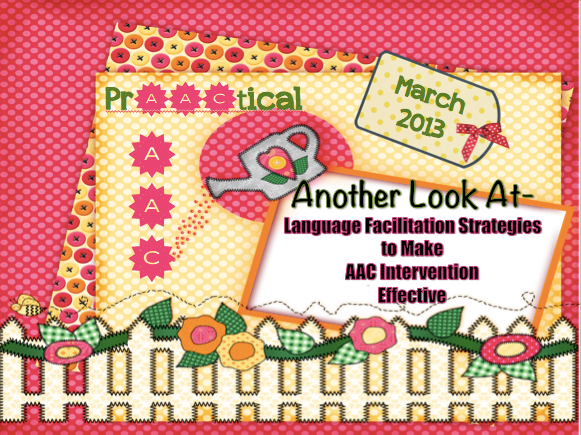
Language Facilitation Strategies The Art of Scaffolding Recasting: A Language Facilitation Strategy F is for Feedback Don’t Miss These Visual Supports & The Chance to PrAACtice Language Facilitation Strategies PrAACtical Teaching Aided Language Input Pivotal Skills for AAC Intervention: Aided Language Input Why We Love Aided Language Input Aided Language Input Demo Learning to Use Aided Language Input Teachers in AACtion- Aided Language Input 5 Ways to Elicit Language Without Asking a Question Don’t Ask: 5 Reasons to De-Emphasize Questions in Your AAC Therapy 5 Tools to Make Aided Language Input Easier F is for Feedback Video
December 21, 2012
by Carole Zangari -
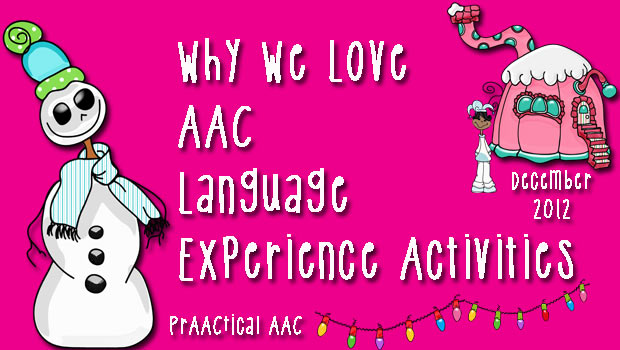
We love hearing the ways in which SLPs are using language experience activities in their therapy. That’s why we woke to big smiles today in hearing the story of a clinician who was having fun teaching the word ALL with goldfish crackers. Her little AAC friends could ask for a cracker and get one, or ask for ALL and get a pre-packaged portion. The power of contrast works in our favor in times like these. And it could easily be done with puzzle pieces or Lego blocks or any number of things. We can highlight it when we ALL leave the room or play a game as a group. Families can get in on the action, too. They can check to see if they have ALL the items from a list in the shopping cart or if they’ve put away ALL the groceries or laundry. Repetition with variety: another of... [Read More...]
November 8, 2012
by Carole Zangari -
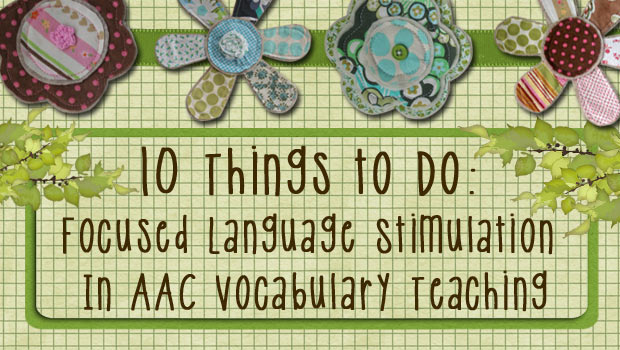
All this month we are talking about considerations in teaching new words to people who use AAC. We’ve talked about the role of focused aided language stimulation and wanted to follow that up with a few more ideas for implementing this strategy. Select the new (target) word to teach giving consideration to Tier 2 words that fit with their language or curriculum goals. Pronounce it. Provide a student-friendly definition Use aided language input: Model the word on the device if it is stored in there OR use the device to explain the new word in a student-friendly way. Find ways to use it throughout the day (and beyond). Hearing the word in various contexts is a great way to deepen the learner’s understanding. Have the AAC learners say it using their AAC (e.g., spelling it out on SGD) or natural speech. Segment it. (E.g., “One of our new words is... [Read More...]
November 7, 2012
by Carole Zangari -
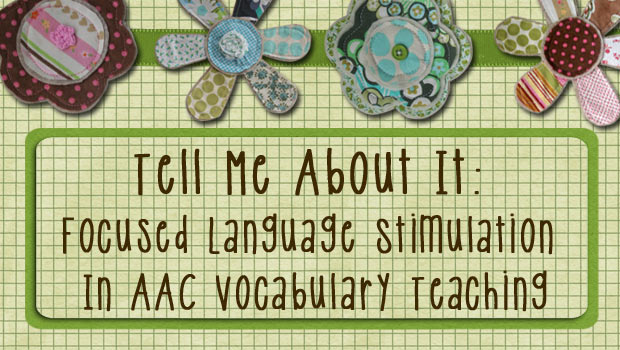
Earlier this month, we introduced a general sequence of how we conceptualize semantic instruction. We promised to elaborate on that. There are two things that I really love about this approach to to vocabulary teaching. The first is that is honors a principle that we know to be true: providing repetition with variety not only helps us reach learners with different strengths, but also gives our AAC learners much-needed practice. The other thing that makes this really work for us is that assessment has an active role but not a central one. Testing takes a backseat to teaching. As we all know, getting accurate assessment information from people who are learning their AAC systems is a huge challenge. Often, our AAC friends don’t have decent test-taking skills so we’re not really testing what we think we’re testing. Just last week I got to see Kristofer, an adorable little fellow who... [Read More...]
June 26, 2012
by Carole Zangari -

SLPs love to talk, of course, but sometimes that works against us. Over-prompting. Jumping in to repeat the last question. Re-phrasing the previous comment. Nature abhors a vacuum and sometimes we just can’t stop ourselves. What makes us fun at parties, though, can make it difficult for our AAC friends to become active, assertive communicators. Too much verbiage on our part can really slow down the journey toward communicative independence. We know better. We really do. But sometimes we need a little help to remind ourselves. And, so, a few reminders to us all… 1. Make the expectations clear using visual supports and aided language input. 2. Create a motivating context in which the learner needs to communicate in order to get his/her own agenda met. 3. Pause. Look expectantly at the communicator. Pause some more. Look even more expectant. 4. Keep pausing. Use a gesture for emphasis (e.g., cup... [Read More...]
June 23, 2012
by Robin Parker -
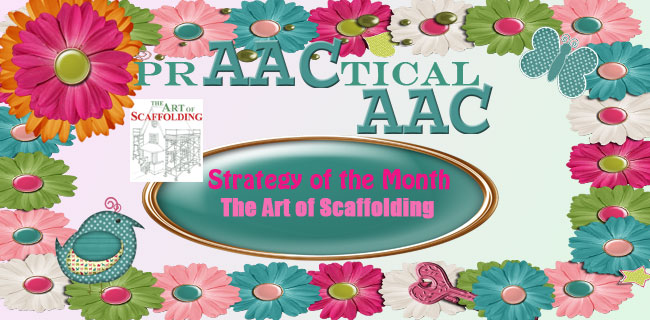
“The best thing about being a teacher is it matters. The hardest thing is that it matters every day. All the time.” Todd Whitaker (Just substitute SLP’s for teachers since SLP’s are teachers of communication and language) As June ends and we finish up with our Strategy of the Month: Language Facilitation Strategies, we do not want to move on without talking about scaffolding. We often use scaffolding without even knowing we are doing it, but for speech-language pathologists, we need to know the name of each strategy we use because that allows us to make the most of everything we say and do when teaching communication and language. Also, when we know what we are doing, we can teach it to communication partners and thus set the stage for language learning at home, in school, and in the community. What is it? Scaffolding is a verbal and visual strategy... [Read More...]
June 9, 2012
by Robin Parker -

“Strategies Are The Secret To Learning” Tony Robbins There are many ways to teach speech and language but we think it is important to remember that the goal should be to teach spontaneous language. So all the strategies we discuss will be part of a responsive conversational style and be real or authentic to conversation. They will be for the facilitator (most often the adult) to use. There should be a purpose or strategy applied to each and every thing we communicate or ‘say’ when teaching language. This extra ‘dose’ of language facilitation is what transitions ordinary talking or language stimulation to specific language teaching/ or speech-language intervention. At the beginning of the month, we introduced language facilitation strategies by talking about aided language input, which is an authentic way of adding visual language and AAC modeling to the conversation. This week we are talking about RECASTS. Recasts serve to add or... [Read More...]
June 2, 2012
by Carole Zangari -
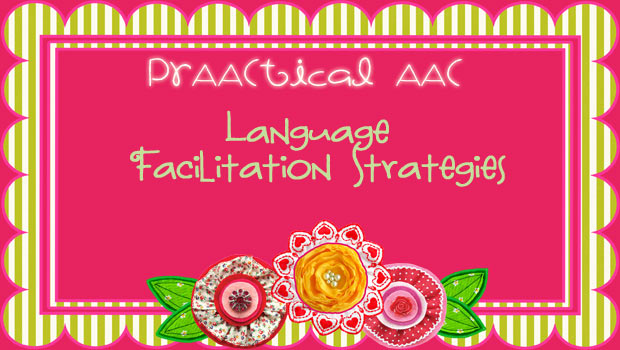
Well, it’s Week 4 of the new semester, and in our AAC classes, we’ve been talking a lot about how language is represented and organized in communication boards/books, SGDs, and AAC apps. We’ve talked about the pros and cons of representing language in various ways and discussed the options for setting up displays so that people can easily access the words they need. At this point, we know how to choose appropriate symbols, select appropriate vocabulary, and arrange it in an appropriate format. In short, we know how to put language ‘in.’ Now comes the hard part: Getting it out. How do we get people to actually use the language that’s been so carefully stored in the no-tech, low-tech, and high-tech AAC tools? Our June Strategy of the Month is about techniques for language facilitation. If you’re an SLP well-versed in language therapy with speaking children, these posts will cover... [Read More...]
February 2, 2025
by Carole Zangari -
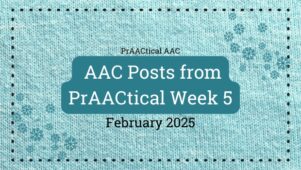
Happy Sunday, AAC friends. It was a busy week full of AAC learning at ATIA 2025 with great sessions and lots of connection with AAC people. Tuesday – AAC Link Up Wednesday – Video of the Week: Mentoring Possibilities for Young People Who Use AAC :::::::::::::::::::::::::::::::::::::::::::::::::::::::::::::::::::::::::::::::::::::::::::::::::::::::: Stick around for some more AAC reading if you can. Here are some suggestions with info and resources from conferences in previous years. Enjoy! PrAACtical Resources: Partner Strategies Handout PrAACtical Fun A PrAACtical Idea for Aided Language Input Toward Improved Diversity in AAC 3 Presentation Handouts on Core Vocabulary Implementation
July 25, 2024
by Carole Zangari -
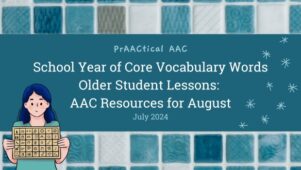
As we prepare for a new academic year, we’re delighted to reconnect with guest authors Michaela Sullivan and Lindsay Dougherty. Today, they kick off preparation for the upcoming school year with another wonderful set of Older Student Lessons in the School Year of Core Vocabulary Words series. Scroll down for some terrific resources, including two slide decks full of activities and the data collection forms specific to the Sugust core words. Their post also includes some helpful information on a key AAC support strategy, aided language input. SCHOOL YEAR OF CORE- Older Student Lessons Access & Copy below: Weeks 1-2 Google Slides Weeks 3-4 Google Slides INTRODUCTION- AUGUST 2024 Welcome back to the School Year of Core – Older Student Lessons: August! School is back in session for many and the summer is nearing the final stretch. Welcome back to the School Year of Core- Older Student Lessons (SYOC-OSL resource,... [Read More...]









